Monterey Bay National Marine Sanctuary
The Monterey Bay National Marine Sanctuary (MBNMS) is a US Federally protected marine area offshore of California's Big Sur and central coast. It is the largest US national marine sanctuary and has a shoreline length of 276 miles (444 km) stretching from just north of the Golden Gate Bridge at San Francisco to Cambria in San Luis Obispo County. Supporting one of the world’s most diverse marine ecosystems, it is home to numerous mammals, seabirds, fishes, invertebrates and plants in a remarkably productive coastal environment. The MBNMS was established in 1992 for the purpose of resource protection, research, education, and public use.
| Monterey Bay National Marine Sanctuary | |
|---|---|
 Big Sur coastline looking north to Bixby Canyon Bridge. Monterey Bay National Marine Sanctuary. | |
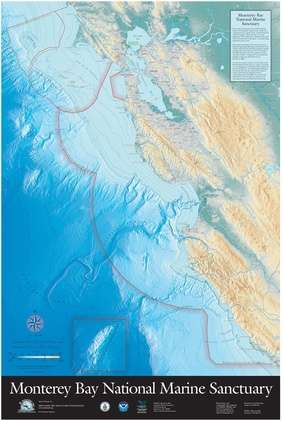 Map of the sanctuary | |
| Location | California's central coast, United States |
| Coordinates | 36°48′N 122°30′W |
| Area | 6,094 sq mi (15,780 km2) |
| Established | 1992 |
| Governing body | NOAA National Ocean Service |
| montereybay | |
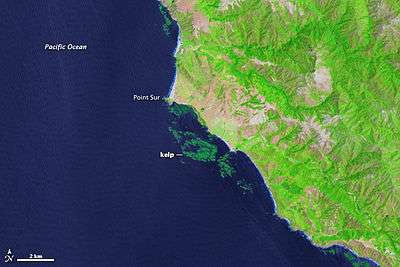
Description
The Monterey Bay National Marine Sanctuary (MBNMS) is one of the largest of a system of 13 National Marine Sanctuaries administered by the National Oceanic and Atmospheric Administration (NOAA), within the U.S. Department of Commerce. It stretches from Rocky Point in Marin County, just north of the Golden Gate Bridge, to the town of Cambria in San Luis Obispo County, and encompasses a shoreline length of 276 miles (444 km) and 6,094 square miles (15,783 km2) of ocean surrounding Monterey Bay. Its seaward Boundary is an average of 30 miles (48 km) offshore, and shoreward boundary the mean high tide. Its area is 6,094 square statute miles or 4,024 square nautical miles. The deepest point is 10,663 feet (3,250 meters) in the Monterey Submarine Canyon, which is deeper than the Grand Canyon. The average ocean surface temperature is 55 °F (13 °C).
The sanctuary provides habitat for 34 species of marine mammals, 94 species of seabirds, 345 species of fish, 4 of turtles, 31 phyla of invertebrates, and more than 450 species of marine algae. Historical sites include 1,276 reported shipwrecks and 718 prehistoric sites. The MBNMS has major programs for research and monitoring, and another for education and outreach
Visitors centers
A Coastal Discovery Center is located across the Pacific Coast Highway from the Hearst Castle visitor’s center in San Simeon, California near the William Randolph Hearst Memorial State Beach.[1]
The Monterey Bay Marine Sanctuary Exploration Center opened on July 23, 2012[2] at 35 Pacific Ave. in Santa Cruz, CA.
Collaborations
MBNMS collaborations include:
- The Sanctuary Advisory Council's twenty voting members represent a variety of local user groups, as well as the general public, plus seven local and state governmental jurisdictions. In addition, the respective managers for the four California National Marine Sanctuaries (Channel Islands National Marine Sanctuary, Cordell Bank National Marine Sanctuary, Gulf of the Farallones National Marine Sanctuary, and the Monterey Bay National Marine Sanctuary), the Elkhorn Slough National Estuarine Research Reserve and the United States Coast Guard sit as non-voting members. Members are appointed competitively by the National Oceanic and Atmospheric Administration and serve three-year terms. The Advisory Council meets bi-monthly in open sessions located throughout the almost 300-mile boundary of the Sanctuary.
- Working groups of the Council: Research Activities Panel, Sanctuary Education Panel, Conservation Working Group, Business & Tourism Activities Panel
- Regional partnerships
- B-WET (Bay Watershed Education and Training Program): a grant program to provide funding and support for environmental education for students, teachers, and communities throughout the Monterey Bay watershed.
Related protected areas
Areas with overlapping jurisdiction include (roughly from north to south):[3]
- Gulf of the Farallones National Marine Sanctuary adjacent to the north
- Golden Gate National Recreation Area
- San Francisco Bay National Estuarine Research Reserve
- Fitzgerald Marine Reserve
- Half Moon Bay State Beach
- San Gregorio State Beach
- Pomponio State Beach
- Pescadero State Beach
- Bean Hollow State Beach
- Pigeon Point Light Station State Historic Park
- Año Nuevo State Marine Conservation Area
- Año Nuevo State Reserve
- Theodore J. Hoover Natural Preserve
- Greyhound Rock State Marine Conservation Area
- Natural Bridges State Beach
- Lighthouse Field State Beach
- Twin Lakes State Beach
- New Brighton State Beach
- Seacliff State Beach
- Manresa State Beach
- Sunset State Beach
- Santa Cruz harbor
- Zmudowski State Beach
- Moss Landing State Beach
- Moss Landing Wildlife Area
- Elkhorn Slough National Estuarine Research Reserve
- Salinas River State Beach
- Salinas River National Wildlife Refuge
- Marina State Beach
- Monterey State Beach
- Edward F. Ricketts State Marine Conservation Area
- Lovers Point State Marine Reserve
- Asilomar State Marine Reserve
- Asilomar State Beach
- Carmel Pinnacles State Marine Reserve
- Carmel Bay State Marine Conservation Area
- Point Lobos State Marine Reserve and State Marine Conservation Area
- Pfeiffer Big Sur State Park
- Los Padres National Forest
- Julia Pfeiffer Burns State Park
- Big Creek State Marine Reserve and Big Creek State Marine Conservation Area
- Cambria State Marine Conservation Area
- William Randolph Hearst Memorial State Beach
- San Simeon State Park
- White Rock (Cambria) State Marine Conservation Area
Events and activities
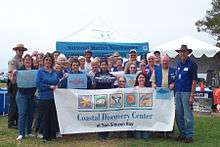
See the MBNMS event calendar for a list of meetings, as well as volunteer events such as Snapshot Day, Urban Watch, First Flush (water quality monitoring programs), and TeamOCEAN (kayaker naturalist program).
The Sanctuary Integrated Monitoring Network (SIMoN) website was launched in 2003 to collect metadata for their various monitoring projects. In 2012, this information was released as an iOS application to allow visitors better access to the over 4,200 photos that have been collected.[4]
History
A Marine Sanctuaries Study Bill was first proposed in 1967, with lobbying efforts by the Sierra Club. The Marine Protection, Research, and Sanctuaries Act of 1972 authorized the United States Environmental Protection Agency to monitor off-shore dumping. In 1975, the California Coastal Zone Conservation Commission recommended a marine sanctuary, and in 1976 Santa Cruz County and Monterey County joined the lobbying effort. In 1983 the Ronald Reagan administration dropped the area for consideration as a sanctuary.[5]
In 1988 congress re-authorized the Sanctuaries Act and proposed a sanctuary in Monterey Bay. However, public hearings, with the memory of the 1969 Santa Barbara oil spill, brought protests demanding a larger size. The first Draft Environmental Impact Statement was released in 1990, and a final management plan in June 1992 proposing the extended area. On September 20, 1992 the MBNMS was authorized by legislation proposed by congressman Leon Panetta. It was the largest federal marine sanctuary.[5][6]
Management
There have been five Superintendents of the MBNMS since its inception:
- Terry Jackson (1992 to 1997):[7] Jackson was a NOAA Corps officer that was assigned to the MBNMS as its first manager in 1992. As a NOAA Corps officer, Jackson's land-based assignment ended in 1997. Over the next year, Jackson hired the first MBNMS staffers. Jackson retired from the NOAA Corps in 1998.
- Carol Fairfield (June and July, 1997): A call for Superintendent applicants went out in the spring of 1997. However, that process was ended by the National Marine Sanctuaries Chief, Stephanie Thornton, because she "did not believe any of the current applicants had the skills she was looking for to be the MBNMS Superintendent."[8] The call for applicants was re-advertised, and Carol Fairfield (with the NOAA's NMFS Protected Resources Program) was selected. Fairfield was selected in June and spent her first month at the Sanctuary Headquarters in Silver Spring, Maryland. Fairfield was reassigned on July 28, 1997, and Thornton said "Fairfield¹s reassignment is a personnel matter which cannot be discussed in detail."[9]
- Joanne Flanders (1997): At the time of Jackson's departure, Joanne Flanders (another NOAA Corps Officer) was Assistant Superintendent. Flanders was appointed Acting Superintendent for about six months.
- William J. Douros (1998 to 2006): In January 1998 William J. Douros, who had previously worked for Santa Barbara County became superintendent.[10]
- Paul Michel (2007 to Present): In 2006 Douros was promoted to West Coast regional director for the National Marine Sanctuary Program. Paul Michel, who had worked at the Environmental Protection Agency since 1987, became superintendent.[11]
Management of northern section
Since the Gulf of the Farallones National Marine Sanctuary (GFNMS) had been established earlier and had a staff already, the section north of Año Nuevo point near the San Mateo County line was managed by GFNMS from its office in San Francisco. By 1996, Terry Jackson of MBNMS requested to have the management boundaries match the preserve. Ed Ueber of GFNMS saw no reason to change.[12]
Oil and gas reserves
There are oil and gas reserves off the coast, but exploration has not been permitted. In 1982, Interior Secretary James G. Watt proposed opening the Central California coast outer continental shelf to oil and gas exploration.[13] California residents and politicians strongly opposed the proposal and it was defeated.[14] In 1990, President George H. W. Bush used an obscure 1953 law to permanently ban oil and gas development in California's Monterey Bay. In November, 2017, President Obama used the same law to ban oil exploration from Hearst Castle to Point Arena in Mendocino County, California.[15]
In July 2017, under the direction of Executive Order 13795[16] from President Donald Trump, the U.S. Department of Commerce began re-evaluating the protected status of the sanctuary, which includes the Davidson Seamount off the coast of Big Sur. The seamount, at 23 nmi (43 km; 26 mi) long, 7 nmi (13 km; 8.1 mi) wide, and 7,480 feet (2,280 m) high, is one of the largest in the world. Opening the area to oil and gas exploration was opposed by many environmentalists and residents.[17]
Gallery
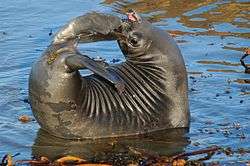 Young elephant seal at rookery, MBNMS
Young elephant seal at rookery, MBNMS A purple striped jellyfish in the sanctuary
A purple striped jellyfish in the sanctuary Anemone, MBNMS
Anemone, MBNMS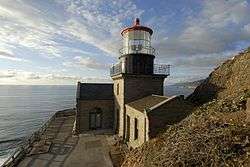 Point Sur Lighthouse
Point Sur Lighthouse
References
- "Coastal Discovery Center at San Simeon Bay". official web site. NOAA. March 31, 2010. Retrieved December 5, 2010.
- "About Sanctuary Exploration Center". Monterey Bay National Marine Sanctuary.
- Guide to the Central California Marine Protected Areas: Pigeon Point to Point Conception (PDF). California Department of Fish and Game. September 2007. p. 8. Archived from the original (PDF) on January 13, 2010. Retrieved December 5, 2010.
- King, C; Lonhart, S (2012). ""SeaPhoto:" Central California Marine Life Featured in New Free iPhone, iPad App". In: Steller D, Lobel L, eds. Diving for Science 2012. Proceedings of the American Academy of Underwater Sciences 31st Symposium. Dauphin Island, AL. Retrieved 2013-10-26.
- "Milestones in MBNMS History". News from the Monterey Bay National Marine Sanctuary. NOAA. Fall 1997. p. 4. Retrieved December 5, 2010.
- Leon E. Panetta (Fall 1997). "Monterey Bay Sanctuary-—Our Treasure". News from the Monterey Bay National Marine Sanctuary. NOAA. p. 3. Retrieved December 5, 2010.
- Terry Jackson (Fall 1997). "From the Captain's Chair". News from the Monterey Bay National Marine Sanctuary. NOAA. p. 2. Retrieved December 5, 2010.
- Quote from public memo issued by Thornton.
- Lisa Ziobro (August 1, 1997). "Monterey Bay National Marine Sanctuary Advisory Council Meeting Minutes". NOAA. Retrieved December 5, 2010.
- "New MBNMS Superintendent: William Douros Takes the Helm". News from the Monterey Bay National Marine Sanctuary. NOAA. Spring 1998. p. 5. Retrieved December 5, 2010.
- "New Superintendent Named for Monterey Bay National Marine Sanctuary". Press Release. NOAA. April 5, 2007. Retrieved December 5, 2010.
- Michael McCabe (June 21, 1996). "Dispute Over County's Coastal Refuge / Jurisdiction of Monterey Bay Marine Sanctuary about to change hands". San Francisco Chronicle. Retrieved December 17, 2010.
- "Big Sur Coast Land Use Plan" (PDF). Monterey County Planning Department. February 11, 1981. Archived from the original (PDF) on June 6, 2011. Retrieved November 15, 2009.
- Lindsey, Robert (May 11, 1982). "Many on Coast Fight Oil Lease Move". New York Times. Archived from the original on 2017-10-26. Retrieved October 25, 2017.
- Parenteau, Patrick (January 2, 2017). "Will Obama's offshore drilling ban be Trumped?". The Conversation. Archived from the original on September 25, 2017. Retrieved 2017-10-25.
- "Executive Order 13795—Implementing an America-First Offshore Energy Strategy - The American Presidency Project". www.presidency.ucsb.edu.
- "California's marine sanctuaries may face new drilling threat". San Francisco Chronicle. Archived from the original on 2017-10-26. Retrieved 2017-10-25.
Further reading
- Michelle Ann Knight (1997). A Political Culture of Conservation: Citizen Action and Marine Conservation in the Monterey Bay. University of California Santa Cruz. Ph.D. dissertation
- Dave Owen (2003). "The Disappointing History of the National Marine Sanctuaries Act" (PDF). New York University Environmental Law Journal. 11. Archived from the original (PDF) on 2010-12-03.
External links
| Wikimedia Commons has media related to Monterey Bay National Marine Sanctuary. |